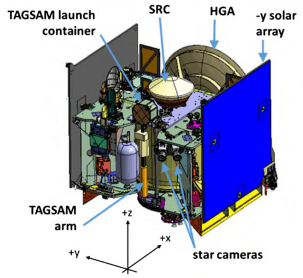 some graphs show the spacecraft orientation according to the figure. Official website page: Spacecraft Coordinate System.
some graphs show the spacecraft orientation according to the figure. Official website page: Spacecraft Coordinate System.The graphs use the following color convention: the red line is aligned with the +Z axis (during a burn, it represents the direction of the thrust vector when the main engines are used, in other words the propellant is ejected from the main engines in the -Z direction); the blue line is aligned with the +X axis and represents the HGA boresight; the green line is aligned with the +Y axis.
